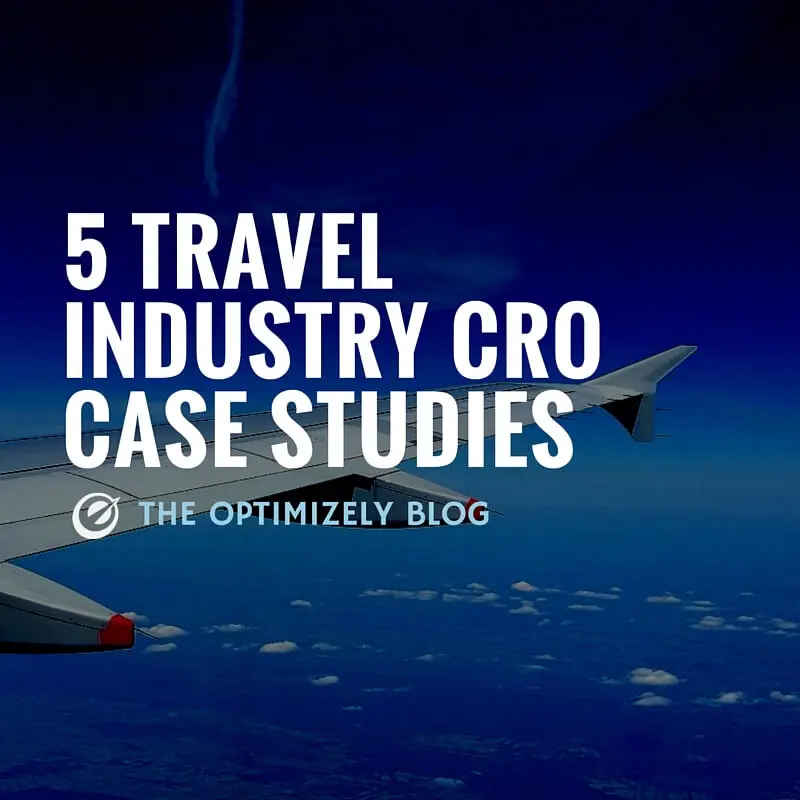5 Travel Industry Conversion Optimization Case Studies
As many travel professionals gear up for Phocuswright next week, we’re sharing a few of our favorite travel conversion optimization case studies from Optimizely customers. Be inspired and enjoy!

Robin Johnson

Online shopping behaviors can certainly be complex, especially when it comes to travel purchases. For consumers in this category, the purchase path tends to be longer, with greater emphasis on browsing, comparing deals, and interacting from a number of different touchpoints. These complex booking behaviors present a challenge that many of the travel industry leaders are tackling head-on with A/B testing and optimization.
As many travel professionals gear up for Phocuswright next week, we’re sharing a few of our favorite travel conversion optimization case studies from Optimizely customers.
Smarter Travel: Doubled revenue from a booking funnel landing page
Smarter Travel, TripAdvisor company, turned to optimization when they noticed a problem with one of their most important pay per click landing pages. The landing page in question served as an entry point to BookingBuddy.com, one of Smarter Travel’s online booking properties.
The problem? A significant number of visitors were landing on the page from search, but very few were actually converting. Bookings and revenue were much lower than expected, so the team to turned optimization to find a solution.
The team ran a total of eight experiments on the landing page over the course of a month, optimizing its headline, background image, call-to-action, form fields, and more.

Click to view the variations in a new window.
Results
The optimized page performed significantly better than the original version. With such a significant win under their belt, the team was able to use the data to push for more budget to invest in display ads directing even more traffic to the winning variation. With more traffic hitting a better performing page, the impact this series of tests had on Smarter Travel’s bottom line revenue grew even further.
Not only did they boost revenue from improved conversions on the landing page, they were also able to proportionately increase the amount of business driven through search. Overall, these changes resulted in doubled revenue per visitor from the BookingBuddy.com landing page.
Takeaway: Test iteratively to maximize impact.
Rather than experimenting with one element here and one element there, testing to evolve one particular page or element over time will help generate the biggest bang for your buck. Taking an iterative approach to optimization helped Smarter Travel solve their conversion challenges and reap exponential benefits from their PPC investments.
Hotwire: Optimized mobile experience
At Hotwire, mobile apps and mobile web experiences are a core part of how travelers book flights, hotels, and car rentals. They recently tested updates made to the Hotwire Cars mobile experience to ensure changes had a positive impact on click through and conversion rates.
To begin, they kept things simple: testing the control against one redesigned variation. As you can see below, the experiment doesn’t focus on a single element of the experience but instead takes a big step away from the baseline. This is a great example of optimizing for the global maximum.

Results
The variation beat the control experience, and was the Hotwire team’s largest winner last year. Now, the team is focused on refinement once again, brainstorming ways to iterate on their new modern look and feel and to apply the learnings from the experiment to other lines of Hotwire’s business.
Takeaway: Take an “explore and refine approach” to optimization to see the greatest impact.
While small, incremental changes can (and do!) lead to positive results, a strong testing program should also focus on big shifts from the status quo (the “explore” phase). Without making major changes, like Hotwire’s test, you may not know what areas of your site could unlock the biggest wins. Exploration and refinement are complementary techniques, and most effective when used in tandem.
Teletext Holidays: Bridged online and offline conversions
With more than 20 years in business, Teletext Holidays has evolved into one of the UK’s favorite travel brands. Travelers use Teletext’s website to browse travel packages, and the company maintains a call center to ultimately help consumers make their final purchase. Phone calls have always been an integral part of Teletext’s sales process, but as they moved toward a more data-driven company mindset, they struggled to find a way to track and measure offline conversions and as part of a complex, online and offline funnel. That’s when they turned to Optimizely.
Results
Using Optimizely’s API, the Teletext team was able to build a sustainable, scalable process for tracking the impact of offline conversions. Now, they have a full picture of each user’s journey through the sales funnel, integrating online and offline data points.
Takeaway: Track the right data to get the full picture of your customers.
Travel purchases can be complex and more often than not, users will interact your business at multiple touch points before making a final purchase. Collecting and analyzing data at each customer interaction will help you understand booking behaviors throughout the journey and provide higher converting experiences at each touchpoint along the way.
Secret Escapes: Increased LTV and doubled sign-ups on mobile
Secret Escapes is a flash-sale luxury travel company that offers discounted deals on four and five-star hotels around the world. Before releasing their first mobile app, the Secret Escapes team had a very important question to answer that many mobile app developers face: should the app require users to sign up? They decided to run an experiment to find out.
They created and tested two different mobile onboarding experiences concurrently. One experience allowed new users to skip or close the sign up screen; in the second experience, sign up was required and the skip button was removed. With the experiment running, the team released the initial version of Secret Escapes to the App Store.

Click to view the variations in a new window.
Results
The mandatory sign up more than doubled the signup rate and did not lead to negative reviews or comments. This experiment also revealed a pivotal discovery about Secret Escapes’ marketing funnel efficiency. Making sign up mandatory justified the cost of mobile ad spend for acquisition by increasing the average lifetime value (LTV) of each user. In other words, the LTV:CAC (customer acquisition cost) ratio was positive: all of the money spent to acquire the user will be matched or exceeded by what Secret Escapes receives from that user.
Takeaway: Testing can unlock efficiencies and ROI that goes well-beyond individual experiment results.
With the data from this test on the first-time user experience and their understanding of lifetime value for each customer, Secret Escapes can make smarter decisions about their advertising spend. They know exactly the amount of money they’re prepared to pay for a new user if they want a full return on investment.
Liftopia: Increased purchases from SEM traffic by 23%
Liftopia is a bookings site that helps skiers and snowboarders search for and purchase discounted lift tickets, rentals, and more. They focus heavily on SEM ads to drive potential customers to their site, and while more traffic is generally seen as a good thing, it recently presented a whole new challenge for Liftopia.
Pages in the site’s purchase funnel offered numerous options for cross-sell. Since the Liftopia team knew what SEM-traffic was searching for already, they hypothesized that showing a tailored experience with exactly what visitors had searched for – instead of options they didn’t want in the first place – would increase purchase conversions and decrease bounce rates. They built a multi-page experiment to test out their hypothesis.

Click to view the variations in a new window.
Results
The variation flow tailored specifically to SEM-traffic search results increased purchases from that important customer group by 24%.
Takeaway: Try simplifying or removing distractions to drive conversions. For many online shoppers (and for travel in particular) less is more, especially as they are browsing and comparing to find the best deal. Try narrowing down the options you provide your visitors to see if it boosts conversions on your site or app.
Looking for more inspiration? Let’s talk at Phocuswright!
We hope these case studies have left you feeling inspired and energized to learn more at Phocuswright next week! Be sure to visit us at Booth #3 to learn how to apply these learnings directly to your website or mobile app to close out 2015 with a bang and blow your 2016 goals out of the water.
